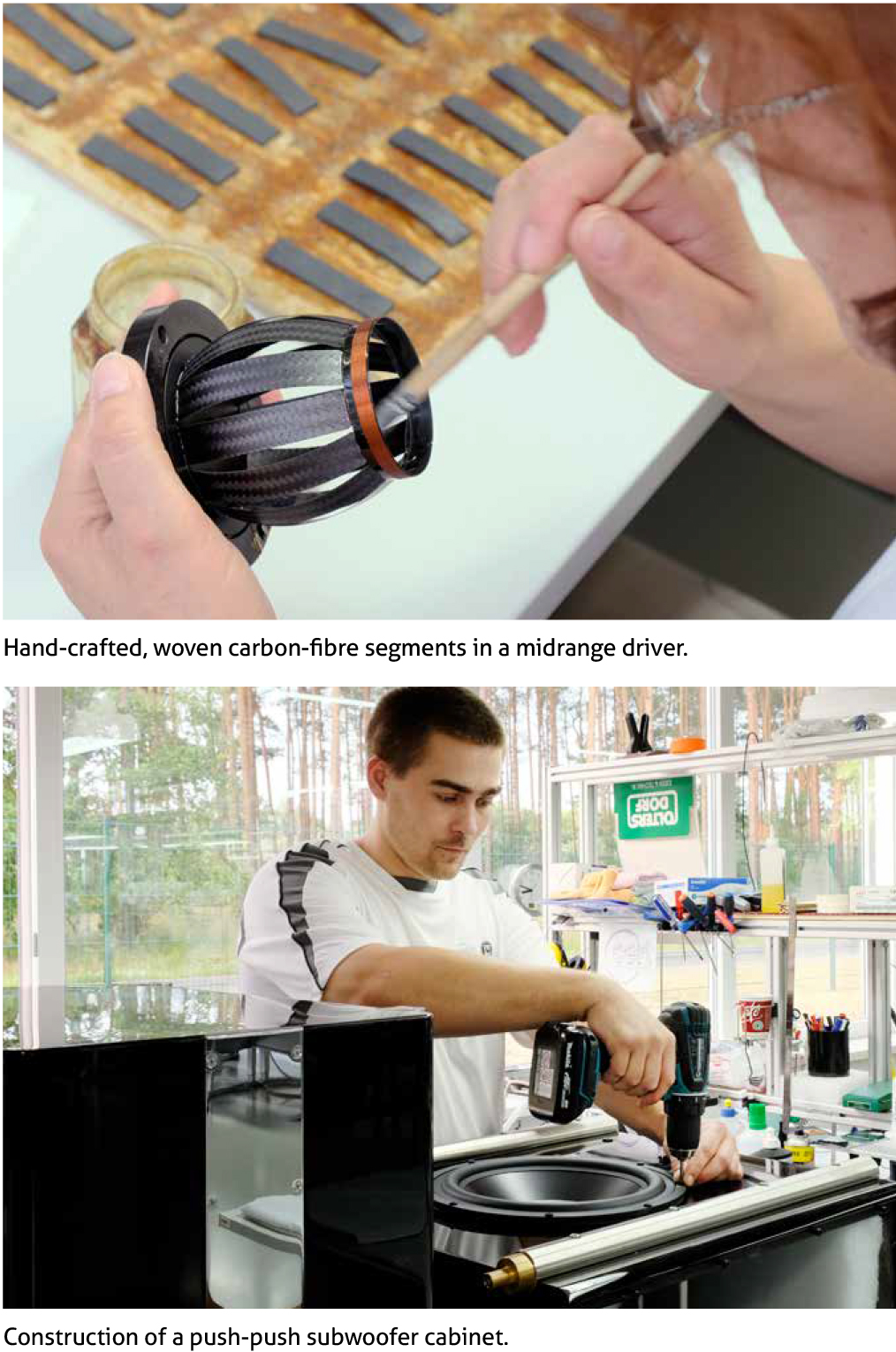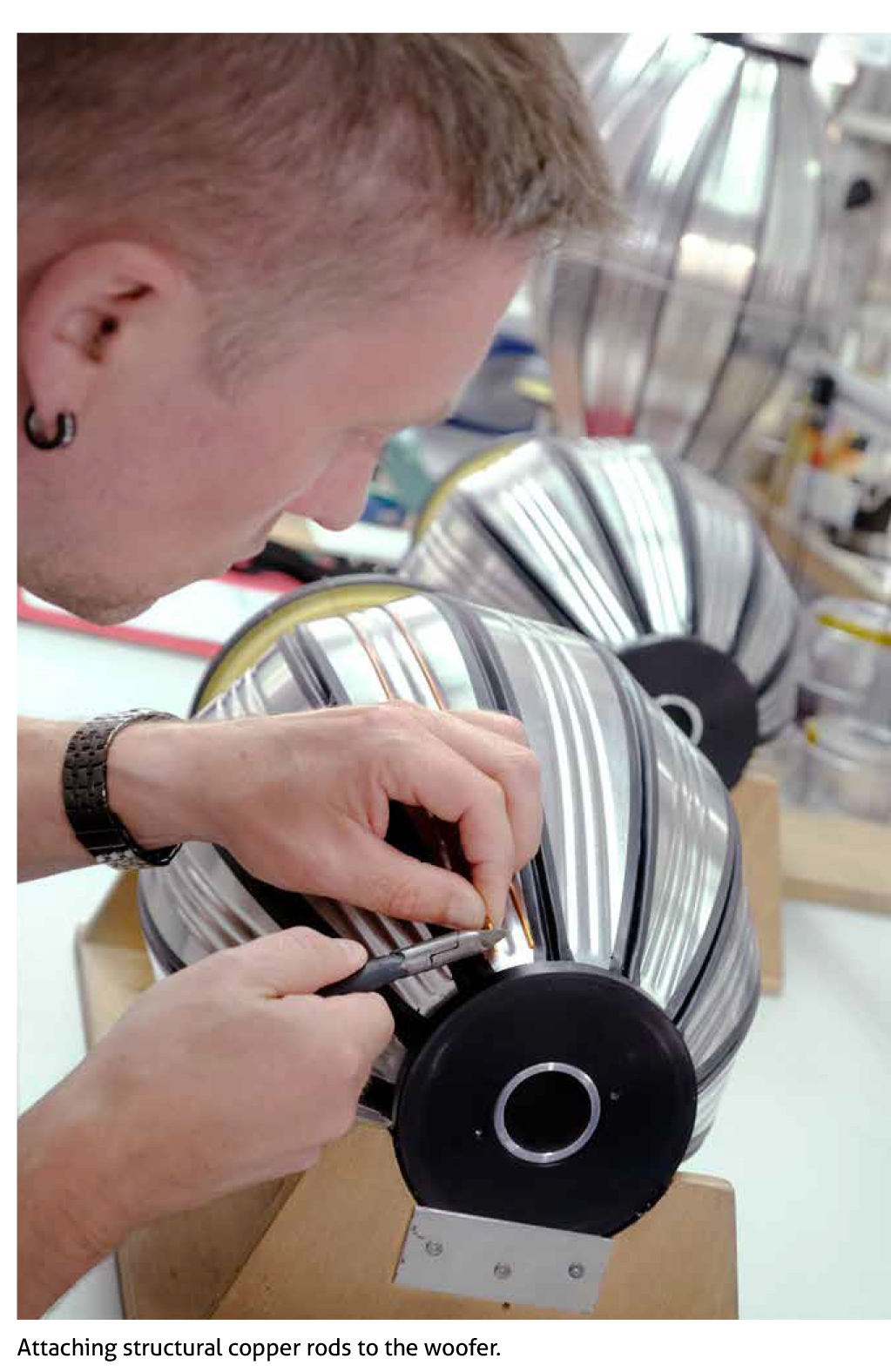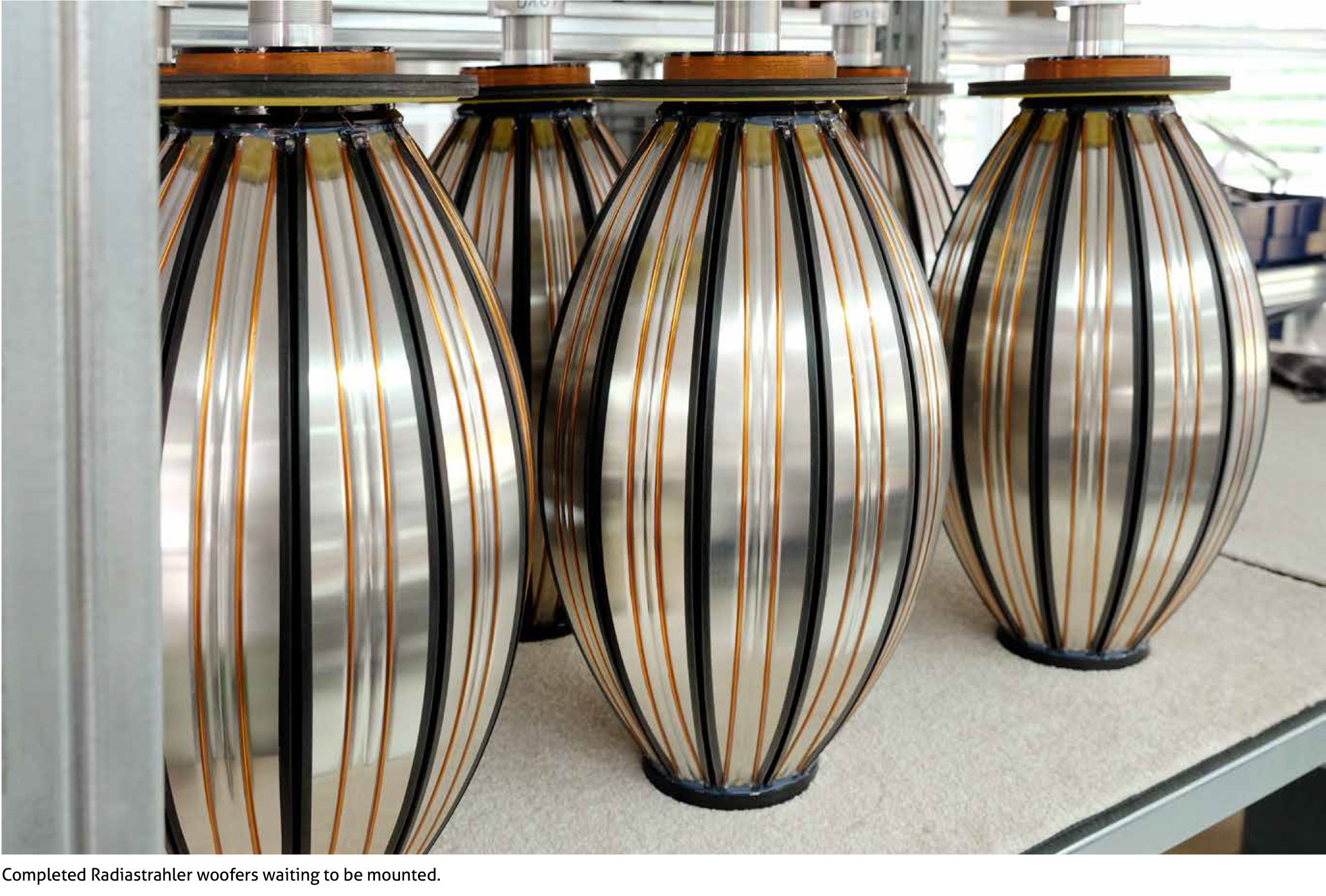Referenční čtení z pera Jonathana Valina - mbl 101 X-treme
MBL 101 X-treme Omnidirectional Loudspeaker
Being There
Jonathan Valin
The exceedingly large, extremely heavy (better than a ton and a half), eight-chassis, twenty-six-driver, $263,000, omnidirectional MBL 101 X-tremes are, in almost every way possible, the best loudspeakers I’ve heard in my home-or anyplace else, fot that matter. As true point sources (which is to say, literal pulsating spheres), they are capable of feats of sonic legerdemain that neither dipoles nor direct-radiating loudspeakers can match, chief among which is the trick of turning your listening space into a near life-sized diorama—an uncannily three-dimensional replica of the venue in which your music was recorded, of the artists who were performing in that space, and of the instruments on which they were playing— that seems less like it’s being generated in bits and pieces by membranes or cones and more like it’s been transported whole and complete from one place and moment in time to the here and now.
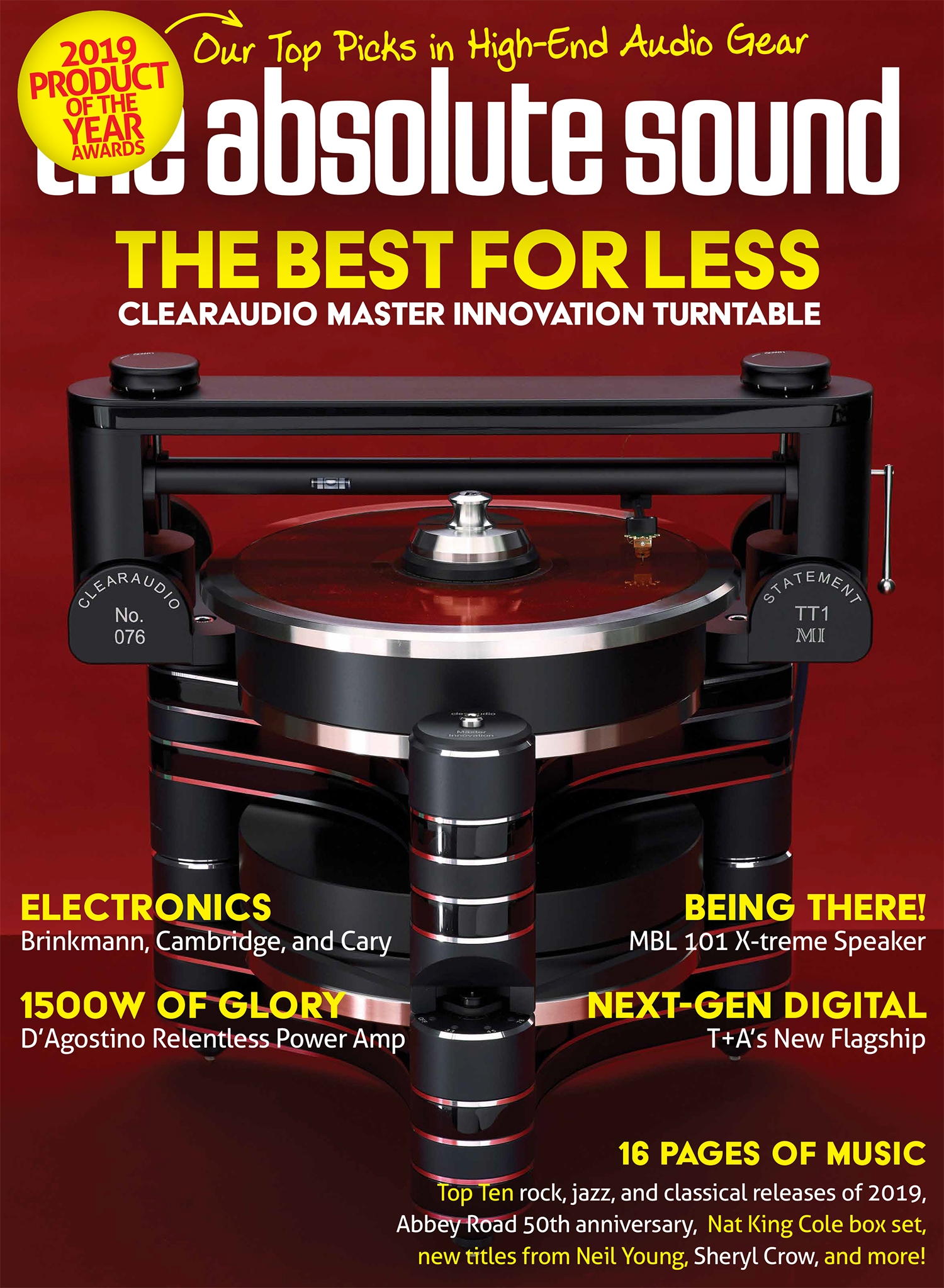
It is a simply amazing feat of stereophonic magic that every high-end audio system aspires to but that only the X-tremes (in my experience) can bring off. To hear the way Ben Webster’s tenor sax and Gerry Mulligan’s bari (along with Jimmy Rowles’ piano, Mel Lewis’ drumkit, and Leroy Vinnegar’s standup bass) leap out at you in three dimensions on Billy Strayhorn’s “Chelsea Bridge” (from AP’s Gerry Mulligan Meets Ben Webster) —completely “there” in your room, only there within a soundfield that is manifestly not that of your room but of your room resized and blended with the acoustic of the studio venue in which this set was recorded way back in 1959—is to feel the time-machine chill that you only get when an approximation of musicians playing in a hall or a studio suddenly verges on the real thing.
How the 101 X-treme is capable of turning water into wine is a complex question that requires a complex answer. As I have reviewed this speaker once before—roughly a decade ago (celebrating its tenth anniversary is the occasion for this re-visit)—I will be drawing in part on what I’ve previously written, in part on what the 101 X-treme’s brilliant designer Jürgen Reis has shared with me, in part on what the late Siegfried Linkwitz, the highly influential audio engineer recently eulo- gized in TAS by my eloquent colleague Robert E. Greene, had to say about loudspeaker design and practice (Linkwitz was a great proponent of monopoles and dipoles), and in largest part, of course, on what I’m currently hearing from the newest iteration of these great transducers. I’ll try to keep things fresh, but if I repeat myself it’s because the best things about the 101 X-treme (and the operating principle it embodies) have not changed.
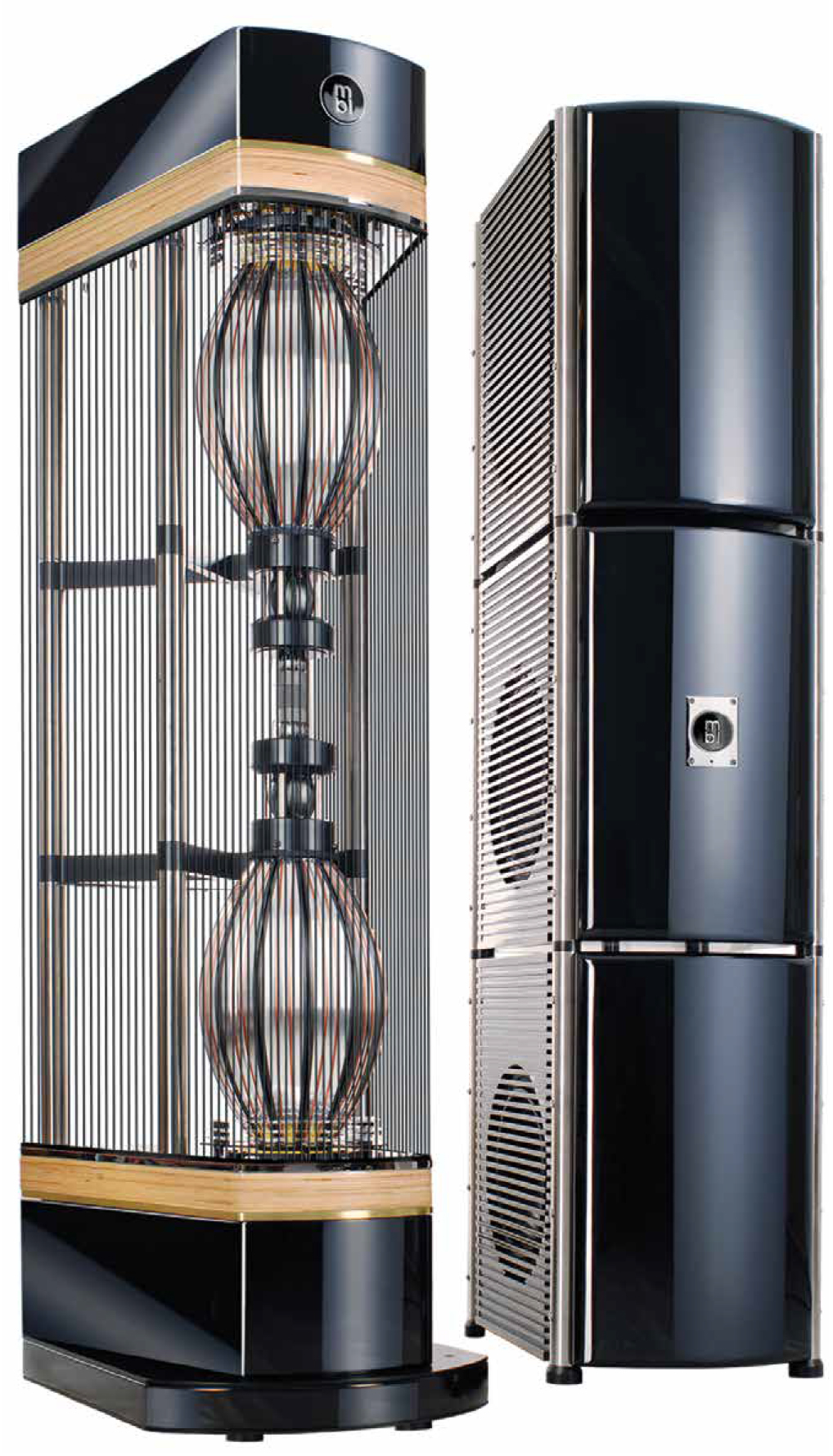
Why Omnidirectional Loudspeakers?
There was a time back in the late 60s and early 70s when omnidirectional loudspeakers were the audiophile rage. Of course, it was the much-maligned Bose 901s that chiefly spurred this craze, followed by a busload of three-sided, four-sided, and six-sided imitators. Though the Boses were not true omnis, which is to say they weren’t generating equal amounts of sonic energy in all directions at all frequencies, they did use the listening room, and particularly the wall behind them, in a way that most other loudspeakers of their day did not—and that acoustic instruments in concert halls always do.
You see, better than 70% of what we hear at a live event is not direct sound but indirect sound bounced off the walls, floor, and ceiling of the venue—reflected energy that profoundly affects the timbre, the dynamics, the durations, the imaging, the very character of the sonic presentation.
Why hall reflections play such a large part in what we hear has to do with the way instruments make music. A violin, for example, doesn’t launch a series of notes in a single plane or in a single direction, as if it were emitting a tightly focused beam aimed directly at you, the listener; it radiates its energy throughout 360 degrees, both verti- cally and horizontally, casting sound into space the way a softly glowing bulb casts light. Of course, that violin isn’t generating the same amount of energy at every vector or at every pitch. But it is always radiating in three dimensions, and therefore always merging its direct sound with the indirect sound it is reflecting off the walls, floor, and ceiling of the hall in which it is being played. Another way to put this is to say, as Amar Bose famously did, that instruments behave acoustically like “pulsating spheres” (or point sources), which because of their spherical wavelaunch always produce a mix of direct and reflected sound in any room at any listening position.
It is only a small (though daunting) step to conclude that if instruments invariably behave like point sources, loundspeaker should, too-that to accurately reproduce what an instrument sounds like in a concert hall or a studio, speakers should also mimic that instrument’s 3-D radiation pattern, which is so intimately tied to our perception of its tonality, dynamics, durations, and presence.
That’s the theory, at least. And as I pointed out on the Gerry Mulligan/Ben Webster LP, with the 101 X-tremes the theory proves out beyond highest expectations. I personally have never before heard a baritone or tenor saxophone (or a piano or a bass fiddle or a drumkit or...you name it) reproduced with the same density of color, weight, solidity, and three-dimensionality—the sheer in-the-room-with-you presence—that the 101 X’s bring to the party. Those saxes (and other instruments) are just there, playing for you in your listening space. As I said ten years ago in my review of the original version of the X-tremes, “while we all listen, perforce, blind to stereo, the 101 X’s go farther towards compensating for our hunger to see what we hear—to fulfilling the definition of the word ‘stereo’ (which literally means ‘three-dimensional’ or ‘solid’)—than anything else I’ve auditioned.”
In addition to their incomparably full and realistic reproduction of tone color and 3-D presence, omnis have obvious sonic benefits when it comes to soundstaging and imaging—one of which you can demonstrate to yourself by merely abandoning the “sweet spot” midway between those cone loudspeakers currently ensconced in your lis- tening room. As you already know, when you move right or left of center, so does the soundstage, which tends to collapse towards the speaker you’re nearing, as if the instruments and vocalists were gradually sliding off a tabletop tilted in the direction you're heading.
This does not happen in real life. If you move from centerstage to a seat at stage left or stage right in a concert hall (or a rock club, for that matter), the soundstage does not “collapse.” Oh, the instruments located in the direction you’ve moved sound louder and more prominent (because they are, in fact, louder due to your closer proximity to them), but the rest of the orchestra or band still spans the stage in the opposite direction, the soloist/vocalist still sounds roughly centered, the hall’s ambience still encompasses all instruments evenly, rather than thinning down in the distant direction and thickening up in the proximate one. With an omni, you get the very same effects you hear in real life. Sitting, standing, shifting your head or your seat, you experience the same stable imaging and soundstaging.
As a dyed-in-the-wool audiophile, listening alone with your “head in a vise” may be something you’ve grown used to (as I have), but it is certainly not the most natural or relaxing way to enjoy music; nor, when it comes to your non-audiophile visitors, is it the most congenial. I don’t know how many times I’ve told some bewildered newbie to “sit in the center”—and if, as is often the case, there is more than one such visitor, to “let so-and-so have the sweet spot.” It’s rude and embarrassing—and one of the chief reasons, beyond the baffling complexity and absurd expense, that so many FNGs find high-end audio off-putting. While omnis like the 101 X’s certainly won’t solve the complexity or expense problems, they will go far towards making listening to music the non-conditional joy it is (and ought to be).
And then there’s the felicitous way omnis deal with an audio- phile’s chief bugaboo—the listening room and its inevitable “issues.” While some of our contributors seem to believe that every room problem can be solved via a good dose of DSP salts, I do not. EQ’ing outboard subs (whose output is inherently omnidirectional) to iron out room modes in the bass is one thing (and generally a salubrious one); DSP’ing an entire system (whose output is highly directional) to make it measure “flat” or rolled or whatever flavor you choose is another. In my experience, you may be able to get things close to the way you want them to be at one roughly microphone-sized spot right smack between your loudspeakers, but what is being scanted or ignored here is just how much more completely and unavoidably such adjustments lock you into a single listening “sweet spot.” Talk about having your head in a vise! In a DSP’d system, if you move your noggin sufficiently right or left or up or down, or (God forbid) switch to a different chair, all that painstaking digital manipulation will be audibly compromised. Sometimes, it will go right down the drain—in fact, moving off-DSP’d-axis may make room problems much worse.
Omnis in general (and the 101 X’s par excellence) deal with room modes in an entirely different, rather more “generalized” and purely acoustic way—by flooding the entire listening space with full-range sound, coming (because the speakers radiate omnidi- rectionally both horizontally and vertically) from a nearly infinite number of different elevations and a nearly infinite number of different angles. You might think that en- ergy being broadcast in equal amounts at all frequencies toward literally every surface of your room would make the sound you end up hearing a confusing, echochamber-like mess. That it doesn’t has to do with two interrelated phenomena: a true omni’s (like the 101 X’s) frequency-independent, constant-directionality dispersion, and the Precedence Effect.
First, unlike conventional loudspeaker drivers (particularly tweeters) that tend to send intense spotlight-like beams of inherently more distorted off-axis sound toward sidewalls, an omni doesn’t “selectively” energize specific spots on your walls. As I noted, it doesn’t work like a specular flashlight. It works like a glowing ball. It energizes your room uniformly at all frequencies, so that any reflections will comprise the entire signal and not a small piece of it.
Of course, an omni is (by design) still creating far more broadband room reflections than a direct radiator, but we don’t hear them as echoes or distortions because of the Precedence Effect. The Precedence Effect is a psychoacoustic phenomenon whereby the acoustic signal arriving first at our ears suppresses our ability to distinguish any other signals, including echoes and reverberations, that arrive up to about 40ms after that initial signal (provided that the delayed signal is not 15dB or so louder than the first one). Instead of those late-arriving wavefronts being heard independently, they are “fused” by the brain with the first-arriving wavefronts and perceived as coming from the same spatial location. (These later-arriving broadband reflections also add volume level and spaciousness—particularly a sense of width—to the sound source, which helps account for the greater sense of presence, openness, and dimensionality that omnis, and the 101 X’s in particular, offer the listener.)
Far from being more colored by room reflections, drivers, and enclosures, sophisticated (and in the 101 X’s case, boxless) omnis can, in principle, be much less colored by all these things and much more faithful to sources (about which I will have more to say) because with proper setup they essentially take the room sound out of the equation. Thanks to the Precedence Effect and the fact that the speakers are lighting up reflective surfaces uniformly at all frequencies and all angles rather than selectively at specific frequencies and specific angles, your room no longer exists as a separate entity—like a picture frame within which the recorded soundstage is mounted (which is the way soundstaging generally works with a direct-radiating loudspeaker). Instead, the entire listening room merges with the recorded room, producing a wall-to-wall-to-floor-to-ceiling soundfield of astonishing layered depth, width, and height, and uniform ambience.
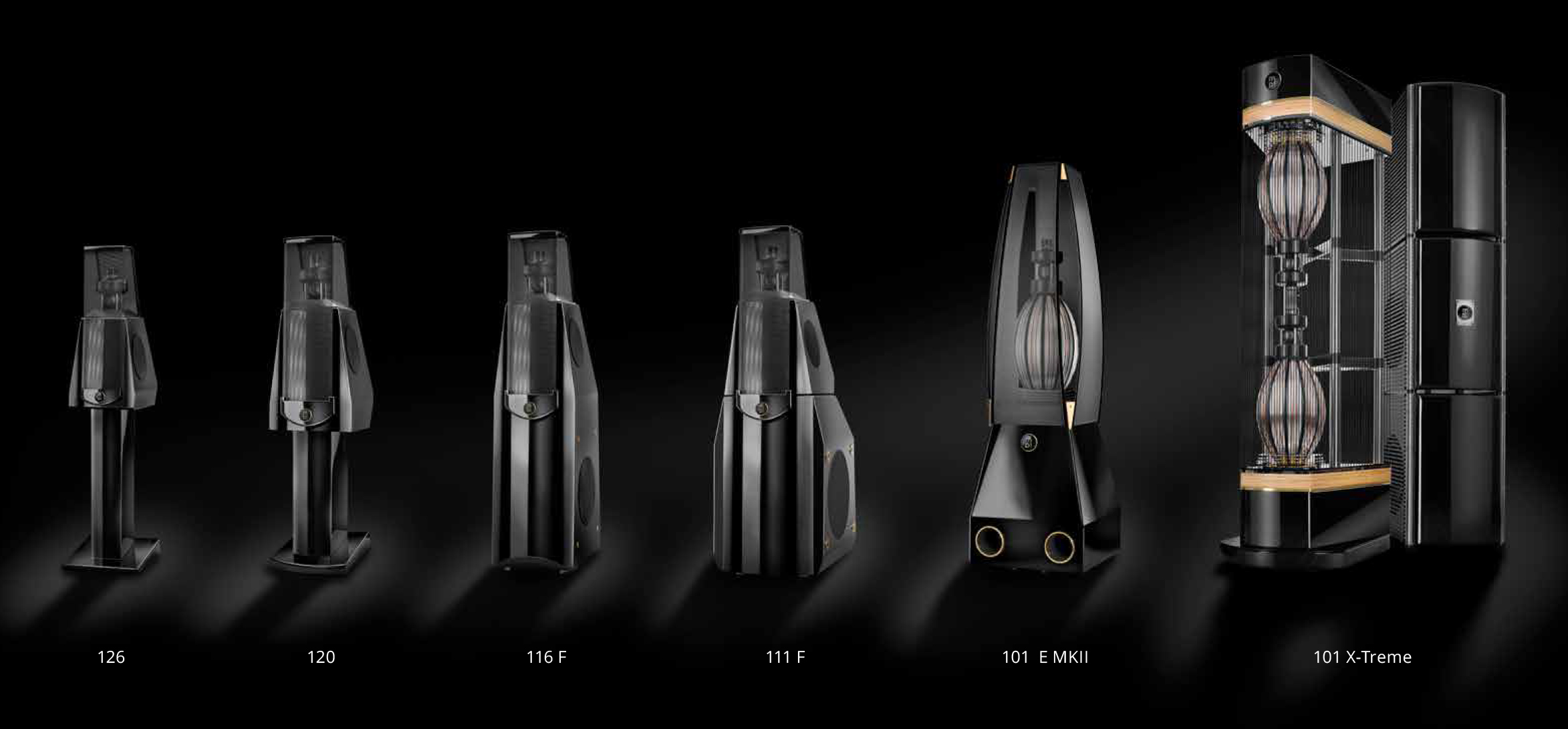
MBL Omnis and How They Work
Despite the brilliance of their design principle and the important things they got right, early omnis, such as the original Bose 901s and their many multifaceted descendants, were still essentially cones in a box—and liable to all the problems that cones and boxes entail. Notwithstanding the Walsh driver (an incredibly brilliant concept that suffered from a plethora of practical problems which initially limited its viability), it is puzzling that no one thought to make a pulsating spherical driver to imitate all those pulsating spheres in an orchestra or a band. And then along came MBL, which did that very thing, and then, a decade or so later, along came a world-class engineer named Jürgen Reis, who perfected MBL’s Radialstrahler concept and eventually designed the 101 X-treme that is the subject of this review.
In spite of all the genuine advances that have been made in the materials that cones and enclosures are made of (and, don’t get me wrong, those materials have greatly improved box-speaker sound), there isn’t anything fundamentally new about moving-coil loudspeakers (or about planars or ’stats or horns, for that matter). They are mature technologies, several of which have been around for almost a hundred years (more than that for horns). Yes, a carbon-fiber woofer is different (and sounds markedly different) than a paper or a plastic or a woven-fiber or a ceramic one. But it’s still a cone woofer with a surround and a spider, and it’s still sitting in a gigantic box (nowadays made of aluminum or carbon-fiber or some mystery-meat material called “X,” “Y,” or “Z”). A Radialstrahler, folks, isn’t like that. It’s not just another pretty face in the same old annual beauty pageant.
What is a Radialstrahler? It is a free-standing (unenclosed) spherical driver using a membrane made of bent segments that are fixed on one side and connected to a voice coil on the other. In MBL’s classic 101 E floorstander—the current version of the company’s original “radial loudspeaker” (which is what Radialstrahler means)—there are three spherical drivers mounted directly atop each other (and a conventional, ported subwoofer mounted beneath the radial array). The woofer (the large, bottommost radial driver) comprises 12 bent segments (called “lamella”) made of a proprietary alloy of magnesium and aluminum and arranged in a quasi-spherical (or melon-like) shape. The smaller midrange driver, which sits atop the cap piece of the woofer, also comprises 12 bent segments, made of a woven carbon-fiber material and arranged in a sphere. The even smaller tweeter perched atop the midrange’s cap piece has 24 bent segments, made of a proprietary unidirectional carbon material and also arranged in a spherical shape. When the drivers' moving coils move, the segments of the spherical drivers flex, creating sound pressure throughout 360 degrees, hori- zontally and vertically.
As all drivers share the same central axis, the listener gets, in designer Jürgen Reis’ words, the same “timing of the woofer, midrange, and tweeter...our alignment allows all frequencies to reach the listener’s ears at the same moment, just as they do in nature.
The 101 X-tremes
MBL’s flagship loudspeaker, the 101 X-treme is essential- ly two 101 Es without their subwoofers and subwoofer cabinets. One trio of radial drivers (woofer, midrange, tweeter) faces upward and anotherm, immediately above it, down, in a mirror-image or D'Appolito arry. The bottom trio of Radialstrahlers is mounted on a massive (over 500 pounds) base constructed of birchwood, brass, and aluminum in a constrained-layer sandwich of birch, brass and aluminium, with a high-quality dynamic "ambience tweeter" nestled out of sight on its roof. Struts and cross members provide top-to-bottom and side-toside structure and support. There is no enclosure. Each speaker weighs half-a-ton.
In addition to the gigan- tic Radialstrahler “towers,” the 101 X-tremes come with two six-and-a-half-foot-tall subwoofer towers that weigh better than a quarter-of-a-ton each all by themselves. Each sub array comprises three ported, lacquered-birch and aluminum boxes, fitted on top of one another via heavy-duty aluminum pegs and sockets, with the sub crossover con- trols and the MBL amplifier that drives the entire array housed in the middle box. Two 12" aluminum-cone drivers with very wide and flexible surrounds are mounted in a push-push configuration inside each of the three boxes—one woofer on the right side of the enclosure, one on the left, both stabilized and cross-braced by a massive aluminum rod running between them to prevent the drivers from passing resonant energy to each other and to the box itself. That makes a total of six 12" woofers per speaker-side, twelve 12" woofers altogether. That, my friends, is a lot of bass.
Although the 101 X-tremes break down into pieces, the pieces themselves are massive (roughly 300 to over 500 pounds each). With the invaluable help of three of the strongest human beings on earth (piano movers from the Cincinnati company of Elam and Sons), Jürgen Reis (who had come over from Germany to assist) and Jeremy Bryan (MBL's U.S. importer and setup expert) managed to haul the 101 X's upstairs to my third-floor listening room.
As was the case when I had the 101 X's ten years ago, setting up and dialing in the system was a two-day affair. The original installation involved many large and small adjustments in the physical location of the Radialstrahler towers and their woofer stacks; the second install went more smoothly, as Jürgen and Jeremy were familiar with the sound and layout of my room. Adjustments of the controls for each of the twelve Radialstrahler drivers and the two ambient tweeters on top of the Radialstrahler towers were done by ear, but tweaking of the gain, group delay (phase), and Q of the woofer stacks was augmented by measurements. (The crossover point between the woofer stacks and the Radialstrahlers is fixed at 105Hz with a 24dB/octave slope.)
Unlike the last time I had the X’s, Jürgen and Jeremy used (at my request) a DSP device ahead of the subs, between the MBL 6010 D preamp and the subwoofers’ built-in Class AB power amplifiers. As I said earlier, DSP’ing or analog EQ’ing subwoofers has been a positive in my experience—and it certainly was here.
Other differences from Jürgen’s first visit involved factory-installed improvements to the 101 X-tremes that MBL has made over the years: 1) the voice-coil formers of the tweeter and midrange are now constructed of a non-conductive material that eliminates eddy currents during the movement of the voice coil and, thus, any brakes on current flow; 2) the midrange support plate and support rods have been moved from the outer to the inner section to improve stabilization and shift any resonances out of the driver’s working range; 3) the cool-down process used in making the aircraft-grade aluminum segments of the radial woofer has been improved to reduce tension in the material and get a more fluid and “stressless” sound; 4) the group delay response of the woofer has been refined; and 5) composite materials are now used in construction of the struts and rods in the D’Appolito tower’s support system to further suppress resonances and improve stability.
After the boys left, I fiddled a wee bit with the controls on the subwoofers and with the level of the ambient tweeter atop the Radialstrahler stack to get the blend I preferred on the bottom and at the very top. Like everything else MBL makes, these controls worked with extraordinary precision, so no big changes were necessary—just a turn of a minute or so on the dials and I was ready to listen.
The Sound
Auditioning the 101 X’s was a virtual replay of their original sojourn in my room. Then as now I can’t stop listening to the things. Then as now visitors—friends, colleagues, and manufacturers—think they are the best transducers they’ve ever heard (as do I), and each of them has had the same slack-jawed initial reaction to hearing them, expressed in almost exactly the same words: “Where are the speakers?”
Despite any shortcomings (and I will come to these), the MBL 101 X’s (properly situated and adjusted) sound less like loudspeakers than any other system I’ve heard.
As I wrote the first time around, “all of the various ways in which conventional transducers betray that their sound is being projected in narrower or broader dispersion patterns by individual drivers in resonant enclosures simply aren’t present.” What you hear, instead, as have been magically imported in toto from some other place—from a concert hall or a studio—and plopped down in your listening room with all three of its dimensions intact. To quote again from my first review, “where other transducers sound the way a film looks—like a two-dimensional medium imitating a three-dimensional reality— the 101 X-tremes sound the way a theatrical play looks—no ersatz third dimension, but actual people on an actual stage right there in front of you.”
Tonally, the 101 X’s are a bit bottom-up in balance—at least, they are when driven by the bottom-up-sounding MBL 6010 D preamp and two pairs of MBL’s 840W/40A 9008 A monoblock power amps. (I’m using two pairs of 9008’s, one pair per speaker side, because having two nominally 4-ohm 101 E’s in each Radialstrahler tower lowers their joint impedance to 2 ohms—a tough load for any amplifier. To be safe rather than sorry, I use one monoblock amp for each individual 101 E in the mirror-image pairs, and thereby sidestep the impedance-drop issue. I will be finding out how a single pair of monoblocks fares in the near future, when Vitus’ Signature Series SM-101 and Constellation’s top-flight Hercules II amplifiers are slated to come my way.)
Though timbre tends to be rich and darkish through the X's, it is not excessively so. From Diana Krall's playfully sultry contralto (on her wonderful cover of Joni Mitchell's great song "Amelia" from Joni 75) to Birgit Nilsson's steely Wagnerian soprano (on her icy and incomparable Elektra from the eponymous Strauss opera), from Hans Theessink’s Johnny-Cash-like bass-baritone on his terrific cover of “Sympathy for the Devil” (from Jedermann Remixed/The Soundtrack) to Richard Manuel’s scorched baritone on “The Shape I’m In” (from The Last Waltz—of course—though the versions on Stage Fright or Rock of Ages are just as memorable) to Neil Young’s sweet shaky tenor on “One Of These Days” (from the wonderful autumnal album Harvest Moon), vocalists never sound less than lifelike (having heard three of these singers in concert I can attest to this from experience). If anything, the touch of extra fullness, very similar to what you hear in a concert hall (and for the same reason), adds to the realism of vocals by enriching timbre and augmenting the solidity and dimensionality—the sense of rootedness in ambient space—that these speakers are very nearly incomparable at reproducing. (Instruments—from Fender bass to violin, from contrabass to piccolo, from kickdrum to ride cymbal, from tuba to tenor—benefit no less completely from this fullness of tone and 3-D rootedness.)
Possessed of the most seamless blend with main speakers I’ve heard, the sub stacks delve very very deep and do so with precisely the kind of richness you hear from bass-range instruments in real life—nothing is thin or razor-cut (all transient and no body); on the contrary, everything is warm, round, fast, cleanly defined in pitch, beautifully robust in timbre, perfectly timed in duration, and immensely powerful in intensity. (On the descending swirl of chords at the start of Bach’s famous Toccata and Fugue in D minor, which ends on a pedal of thunderous power, E. Power Biggs’ Flentrop organ plunges through the floor and shakes the room just like the real article.) You simply never hear these subs as separate sound sources, in spite of the fact that they comprise twelve 12" cones. As with the Radialstrahlers themselves, those push-push drivers are radiating their energy omnidirectionally—and radiating it at a multitude of heights and angles (thereby reducing the excitement of room modes, particularly when the subs are used in combination with DSP).

Dynamically, the 101 X’s are a wonder, as anyone who has heard them playing all-out at trade show can attest. (At very loud levels they can even make a jazz or rock drum kit, one of the largest and hardest-hitting of instruments, sound as “there” in the room as an oboe or a flute—a sonic feat I’ve only heard once be-fore with the Nearfield Acoustic Pipedreams, though the Pipes’ tar-barrel-sized subs were anything but seamlessly blended with their main columns.)
Part of the reason that MBL Radialstrahlers are so famously and enjoyably dynamic is the sheer amount of energy they are generating thanks to the unusually large surface area of their drivers. Consider a Radialstrahler woofer (the big silver melon-like driver at the bottoms and tops of the Radialstrahler towers). Every square inch of these large spheres is producing sound with the same intensity as the central portion of a conventional dynamic woofer (and without any of the center-to-edge drop-off in force or increase in distortion of a conventional woofer). In radiating area a Radialstrahler woofer is the equivalent of something like twelve 12" cones (the same number found in the sub towers). And each side of the 101 X-treme has two of them! The same thing is true of the Radialstrahler midrange and tweeter.
You might think that drivers this large in area would be slowed down by their mass and would ring like bells being struck when hit with an electrical signal, but their size actually works to their advantage. Since they’re driven over the entire surfaces, they only have to move very small amounts to make very loud sounds (a bit like horn-loaded compression drivers). These small excursions also mean that they don’t have to move very much to stop making sounds. Plus they are made of lightweight materials, and because of the volume of air inside them are virtually self-damping.
What do the X-tremes not do as well as (or far better than) the competition?
Well, they don’t image at center stage with the razor-cut precision of Magico M3s or M6s, though there is certainly an argument to be made for the somewhat larger, slightly more relaxed, far more three-dimensional imaging (and heart-stopping immediacy and presence) of solo vocalists or instrumentalists through the X’s. They aren’t quite as detailed as MartinLogan CLX’s, though they’re certainly no slouches when it comes to resolution (on a par with the very best dynamics), and it is well to remember that their detail is being folded into a three-dimensional image (and therefore not as nakedly exposed and separately audible as it is when details ride on the surface of a two-dimensional image, as they do with a ’stat or a planar or a cone). They don’t have quite the same slam or bottom-octave clarity of JL Audio Gothams—or they don’t at low-to-moderate volumes.
Turn things up, however, and it is a different story. For all their many virtues, other speakers just don’t do three-dimensional volume or lifelike size (without oversize) the way the 101 X-tremes do, so where the drum stroke on a tom or a bass drum may be very clear through a good cone speaker, the sense of the volume of air being excited in the drum’s circular shell isn’t as true-tolife as it is through the X’s. Inarguably, Radialstrahlers are not as extended on top as the best dome tweeters and ribbons. Indeed, the X’s’ radial tweeters roll off steeply and quickly above 16kHz (and are already a bit softer in intensity below that), which is one of the reasons for the ambience tweeter on top of each Radialstrahler array. Having said this, I must quickly add that MBL’s radial tweeters are still genuine marvels—the only HF transducers I’ve heard that do volumes as well as transients and colors. Through the X’s, cymbals have something you rarely if ever hear with domes and membranes—a disc-like roundedness that makes them sound three-dimensional, just as they do in life. (I should also point out that the 101 E’s roll in the treble means that they will not etch transients or artificially brighten up or add unpleasant edginess to harmonics.)
With their plethora of reflections and darker balance, you might well think that another of the X’s weaknesses would be transparency to sources, but you would be very wrong. Indeed, the 101 X’s are high among the most transparent-to-source loudspeakers I’ve had in my home. Why this is the case probably has to do with the absence of noisy, energy-storing enclosures, surrounds, and spiders, the radial drivers’ inherent time-and-phase coherence, their low distortion, their ability to stop and start on a dime, and possibly the sheer volume of sound they generate, but the fact is I haven’t had a speaker in my house that can tell me more clearly and quickly what is right or wrong about a recording or a piece of ancillary gear. (It was simply amazing, for example, to hear the way the 101 X’s sussed out the advantages of a very expensive cable vis-à-vis a cheaper, but still quite good one. Reviewing cables is always a chore, precisely because—outside of tonal balance and resolution—the differences among them take a while to gauge. Through the X’s it took all of two seconds to hear the way the new cables removed the subtle sibilance and midrange forwardness of the older ones.)
Conclusion
You already know what I think. These are the most realistic speakers I’ve heard, and though this has never before been the case, they are also the most musical and unconditionally enjoyable. Having eliminated almost all the things that make stereo systems sound like stereo systems, they are very nearly as unique in their non-stop sonic appeal as they are in their ingenious operating principle and brilliant engineering. Every time you listen to them is a pleasure and an amazement. And every time you stop listening to them, you want to come back. There is, quite literally, nothing else like them. Had I the money, I would buy them in a minute.



